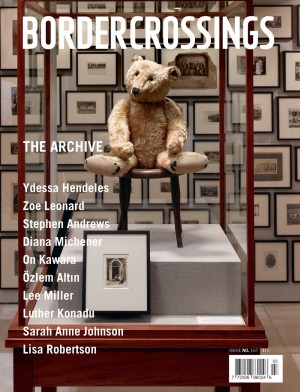Ivan Eyre
Ivan Eyre is an important Winnipeg artist. A permanent gallery at the local Assiniboine Park is testimony to his local stature, while the National Gallery of Canada show in 1988 granted him a place on Canada’s official artistic “A” list.
Three other artists, the wildlife painter Clarence Tillenius, the printmaker Walter J. Phillips, and the sculptor Leo Mol (Eyre’s gallery overlooks a lush garden populated by Mol’s young female nude sculptures), also have “permanent” status at Assiniboine Park, but my guess is that after hemming and hawing and institutional gnashing of dental implants, future city mothers will keep only Eyre’s work (I must also stand somewhat stiffly behind Mol’s erotica) in order to make room for the likes of Wanda Koop, Karel Funk, Shawna Dempsey & Lori Millan, Bev Pike, Tim Gardner and William Eakin.
Winnipeg curator Sigrid Dahle, in an exhibition she organized for the University of Manitoba’s Gallery 1.1.1., recently characterized the art scene in Winnipeg as being steeped in what she called a “gothic unconscious,” and Ivan Eyre was central to her claim. As a University of Manitoba professor, Eyre influenced a generation by suppressing intellectuality in favour of the production of psychologically fraught graphic drawings. Esther Warkov and Diana Thorneycroft both followed Eyre to the dark side, and Winnipeg still tends to identify dark subject matter with art’s cutting edge to the extent that even today it is difficult to convince Winnipeggers that art does not have to be controversial in order to be important.

Ivan Eyre, Mythopoeic Prairie 1, 1965, oil on canvas, 106.2 x 116.8 cm. Collection of the Winnipeg Art Gallery. Gift of the late Mary H. Acheson in memory of her mother, the late Helen E. Acheson.
Art historians will one day trace Eyre’s indirect influence on the current Marcel Dzama generation of Winnipeg artists now in their late 20s and early 30s, youngsters who are already more internationally famous than Eyre. But for that to happen, the current literature’s silence about local influences on young phenoms like the Royal Art Lodge will have to be lifted. The Drawing Centre/Plug In Institute Royal Art Lodge catalogue Ask the Dust, for example, does not mention Eyre at all, favouring narratives about the influence of popular culture, wintry isolation and the odd art star. It seems unlikely that Mike Kelley was more influential on these kids than Ivan Eyre.
Amy Karlinsky’s catalogue essay on Eyre is valuable because it positions Eyre’s contemporaries, such as Richard Williams. in terms of the championing of drawing, but “figure ground: paintings and drawings by Ivan Eyre,” in conjunction with several recent publications about Eyre, including a recent, self-published, doorstop-sized tome called Ivan on Eyre, will not likely constitute the last word on this prairie paterfamilias because, as mentioned, it is too soon to figure in the famous Winnipeg kids.
Eyre’s drawing is kinky, like Winnipeg, much of it hovering just this side of respectability. His depictions of bondage, for example, got him attention long before polite society was familiar with the term, and his sexual fetishism is evidence, at least to my think-ing, of a peculiarly Protestant kind of repressively desublimated sexuality that is part of Winnipeg’s storied edginess.

Ivan Eyre, Double Tatter Wrap, 1992, grease crayon on acetate and acrylic wash on paper, 40.3 x 50.6 cm. Collection of the Winnipeg Art Gallery. Gift of the Volunteer Committee to the WAG.
Kinkiness is strength. Take Eyre’s 1982 painting Storm, for example, in which bandaged and unbandaged self-portraits sit placidly before coffee cups in a studio. Out a large window, black-hooded, black-booted men, naked from the waist down—one with an erection—march through vegetation past a modernist office tower. Dark horsemen glide across the sky. The self-portraits, like shamans, sport bird-like headgear. To Dennis Cooley, whose crisp poems, including one named “twins,” are reproduced in the catalogue next to reproductions, these faces register shock, Storm evoking a vision of the “the cold blue / assemblage & disassemblage of the world.” But does the painter create and destroy worlds out of the kind of “cold blue” indifference of shock, or just for the fun of it? After all, the point of sexual fetishism is a pleasure that is never supposed to be really dangerous.
Storm captures something of Winnipeg’s peculiar downtown space, which, despite having business towers, is not dense. The careful graphic delineation of objects and flattened forms gets Winnipeg’s bright, flat prairie light perfectly. To many collectors, Eyre’s unpeopled landscapes also portray something ominous, perhaps by association with the tortured figural work, but I think that that transference is unwarranted: Eyre’s best art contains figures rendered as clinically as medical illustrations. Could Eyre have abandoned Expressionism early in his career because painterliness is a sign of emotional engagement?
As curator Karlinsky hints, Eyre’s early mentors—particularly Winnipeg Art Gallery director Ferdinand Eckhardt—had a personal stake in German Expressionist art that led to Eyre’s early annointment as the “next thing.” Eyre is very talented and could have painted anything, but at a critical juncture early on he decided to go graphic, as if a constricture of line around a form were meant to convey something like the tightening of a rope or a bandage around a lover’s body, in order to restrict breath and heighten sensation. ❚
“figure ground: paintings and drawings by Ivan Eyre” is on exhibit at the Winnipeg Art Gallery from April 29 to August 28, 2005.
Cliff Eyland is a Haligonian artist and academic who lives in Winnipeg. His public art project for the new Millennium Library in Winnipeg will be installed in the fall of 2005.

